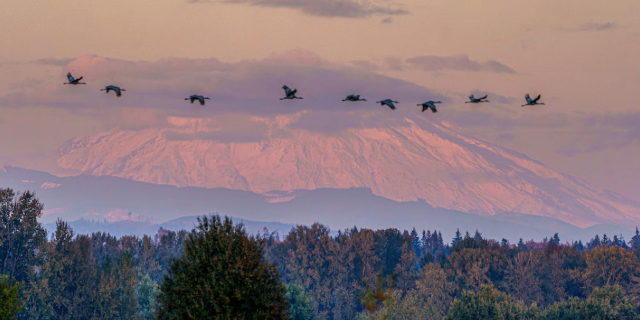Trump cuts could compromise Oregon’s earthquake and volcano warning systems
Published 8:40 am Wednesday, March 26, 2025

- Sandhill cranes fly over Sauvie Island in Portland with Washington state’s Mt. St. Helens in the background. Mark Graves/The Oregonian
At the confluence of multiple tectonic plates, on the Pacific Ring of Fire, sits the West Coast of the United States, where the Cascade mountains in Oregon and Washington are dotted with active volcanoes within striking distance of major metro areas.
The region also is at risk for a catastrophic Cascadia subduction zone earthquake, potentially registering in the high 8 and even 9 range.
Scientists have worked for years to build systems to monitor volcanoes and earthquakes on the West Coast and to keep people safe.
Trending
But funding cuts from billionaire Elon Musk’s Department of Government Efficiency, created by President Donald Trump, threaten these ongoing monitoring efforts as well as the research that could make Oregonians safer in the coming years.
“It’s been a stressful couple of months,” said Peter Ruggiero, an Oregon State University professor who works on earthquake preparedness with The Cascadia Coastlines and Peoples Hazards Research Hub.
“We’re lucky,” he said. “As of now, we’ve had no direct cuts to our program.”
There have, however, already been indirect impacts, Ruggiero said.
His project is in the fourth year of a five-year funding cycle and in the process of preparing its annual report.
But the National Science Foundation funds the project and layoffs and rehiring there has meant, “the people that are in charge of the funding are going to a lot of the chaos,” Ruggiero said.
Trending
Site visits have been canceled and the future is unclear.
The research hub studies preparedness for all kinds of disasters, from earthquakes to climate change, and its work runs the gamut from geoscience behind those disasters to social science related to evacuations and community preparedness and communication.
“All that preparation and mitigation, adaptation work is incredibly efficient money in terms of the more you spend in time and energy upfront, when the actual disaster or catastrophe actually happens, the amount of losses are much much reduced,” Ruggiero said.
Funding these projects saves money in the long run, he said, and it saves lives.
“It would be, from our perspective, a pretty horrendous thing for the region, if that funding was pulled,” Ruggiero said.
So far, Ruggiero said, they don’t expect money to not come through for the next year, but they are concerned that some of the focus of their project, including climate change resilience and engaging under-served groups, are at odds with the priorities of the current administration.
“We’re just doing what we were asked to do originally,” he said. “So this is the kind of the weird catch-22 that many of us are in.”
The Pacific Northwest Seismic Network is also contending with the indirect impacts of the Department of Government Efficiency.
The Pacific Northwest Seismic Network manages a vast network of seismic stations across Oregon and Washington. Those stations monitor earthquakes and volcanic activity, and, said Harold Tobin, director of the network, require a lot of maintenance.
The network works with the United States Geological Survey to maintain these stations, many of which are in remote areas and run by solar panels.
But a spending freeze at USGS means that even though employees haven’t been fired, they aren’t allowed to travel overnight for fieldwork, even if that work is maintaining seismic stations.
“I don’t want anybody to think we’ve stopped monitoring the volcanoes,” Tobin said. “We haven’t. But these are real challenges and they will take a toll over time.”
The data coming from these stations is crucial for understanding volcanoes and earthquakes and ongoing research.
And it also feeds into ShakeAlert, the system that gives people a small amount of warning before an earthquake reaches them.
ShakeAlert detects earthquakes at the epicenter where they start and when three or four stations detect a quake, it sends alerts to people who may be impacted. But ShakeAlert requires the seismograph stations, over 700 of them, to be working.
“The majority of my budget is federal,” Tobin said.
And there’s a reason for that, he noted, echoing Ruggiero.
“It’s been shown over and over and over again, all over the world and certainly in the U.S.,” Tobin said, “money spent on mitigation in advance saves a lot more dollars of recovery after a big disastrous event.”









